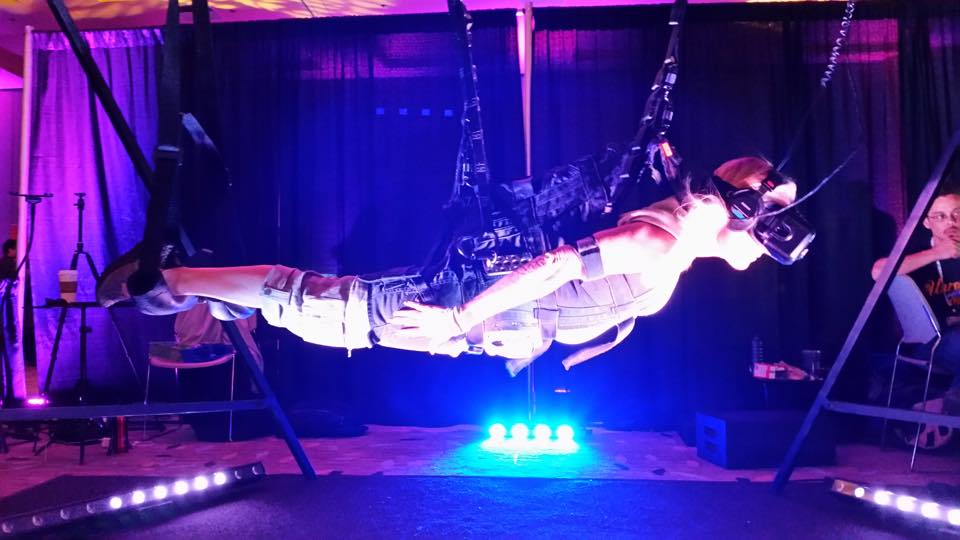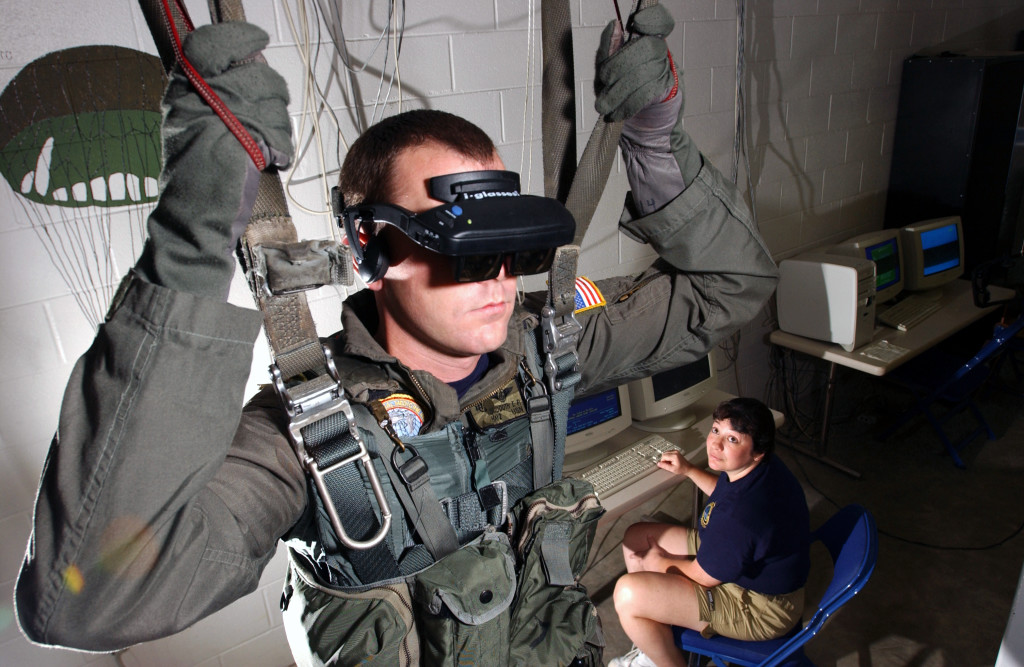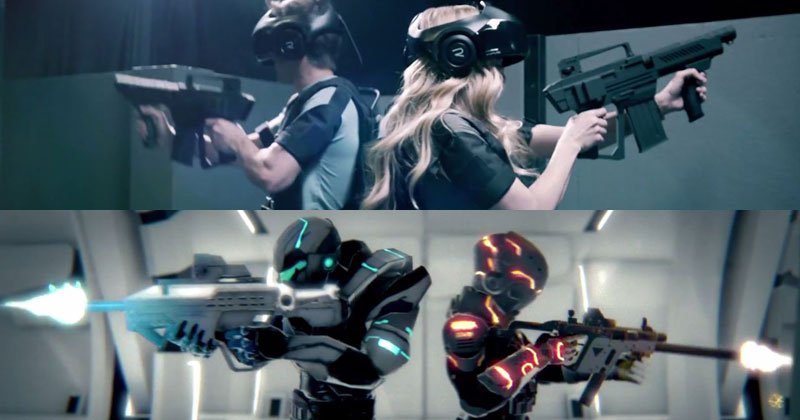-

-

-

-

-

-

-

-

-

-

-
-

-

-

-

-

-

-

-

-

-

-

-

-

-

-

-

-

-

-

-

-

-

-

-

-

-

-

-

-

-

-
-

-

-
 TOTW: Google's Project Ara Modular Phone May Be The Future Of SmartphonesOctober 30, 2014
TOTW: Google's Project Ara Modular Phone May Be The Future Of SmartphonesOctober 30, 2014 -

-

-

-

-

-

-

-

-

-

-

-

-

-

-
-
-

-

-

-

-

-

-

-

-

Posts tagged virtual reality gaming
Fighting A Robot In VR – Midas Touch Games’ BattleRig
08 years
It punched to the right. I blocked. Another punch, this time to the left. I blocked again. I quickly jabbed forward, knocking it back slightly. Regaining its balance, it took a step back, swinging its arms. I took the initiative, hitting it with a sharp uppercut to the jaw. Uppercuts seemed to have the best effect, I noticed. It went flying, landing head over heels. Relaxing, I took the HTC Vive virtual reality headset off. I had just demolished a large red battle robot in a one-v-one fight in virtual reality.
That was my experience with Midas Touch Games’ demo, BattleRig, at Augmented Reality World Expo in Silicon Valley. Midas Touch Games is a company that took on one of the largest challenges to VR yet: touchability, or the ability to manipulate and touch objects in virtual reality. It has taken long enough to make a VR headset capable of producing immersive games, videos, and experiences. But the whole idea of VR relies on immersiveness, and if you feel like you are in an unfamiliar physical world, it can make the experience lack credibility. If you touch an object, say, a book on a shelf, and it doesn’t react, that will temporarily take you out of the experience. In an ideal VR experience, everything you touch will react accordingly, therefore limiting the amount of times you actively think “Oh right, this isn’t real. I’m in virtual reality.”
While the ideal virtual reality experience is obviously still years away, Midas Touch Games and many other companies at AWE are helping to make that experience a reality. We have the headsets, we have the 3D models and 360-degree video, now we need to make that content interactive. And Midas Touch Games is doing just that. The one-on-one fight with a robot I was lucky enough to experience was just one example of their unique joint-based physics for VR. Joint-based physics have been in use in VR for inanimate objects for a while, but when it comes to more complex things like, say, robots, it just didn’t work. Midas Touch has created a joint-based system made especially for character-based simulations, what they call the Midas Physics Engine, a 3D engine for virtual reality characters.
While something called “Midas Physics Engine” may sound like PR jargon, it’s quite substantive. I’ve demoed a fair number of VR experiences, and while flying around a prehistoric landscape full of dinosaurs is stunning, the feeling that you are actually there goes away when you fly directly through a stegosaurus. But when you’re petting a dog, and it actually reacts to your touch, and you are even able to pick it up and push it around, as was the demo at the Midas Touch booth, the experience is much more immersive and memorable. And when you’re fighting a robot, when it’s reacting to your punches and vice versa, you really do feel like you’re there, and for me just simply interacting with the characters in your VR experience goes a long way for taking that next step towards the ideal, completely immersive VR experience.
Augmented vs. Virtual Part 1 – Virtual Reality
19 years
Technologically enhanced vision has been with us for many hundreds of years, with eyeglasses having been in use since at least the 14th century. Without effective sight, living has of course remained possible during this era, but it is a meaningful disadvantage. Now, new technologies are offering the promise to not only make our lives easier, but to also give us new capabilities that we never thought possible.
This idea, enhancing our vision using technology, encompasses a range of technologies, including the two promising arena of augmented reality (AR) and virtual reality (VR). The names are fairly self-explanatory; augmented reality supplements and enhances your visual reality, while virtual reality by contrast creates a whole new reality that you can explore independently of the physical world. Technically, AR hardware generally consists of a pair of glasses, or see-through panes of glass attached to hardware, which runs software that projects translucent content onto the glass in front of you. VR, on the other hand, is almost always a shoebox/goggle-like headset, with two lenses allowing two different screens in front of your eyes to blend into one, using head motion-tracking to make you feel like you are in the virtual world. Both are very cool to experience, as I experienced while attending the Augmented World Expo last week in Silicon Valley, where I have able to demo a host of AR and VR products. This article focuses on my experiences with Virtual Reality gear; next week I will follow-up with thoughts on Augmented Realty.
Virtual Reality
Virtual reality, when combined with well-calibrated head-tracking technology, allows you to be transported into a whole new world. You can turn your head, look around, and the software responds as if this world is actually around you, mimicking real life. This world can be interactive, or it can be a sit-back-and-relax type experience. Both are equally astounding to experience, as the technology is advanced enough so that you can temporarily leave this world and enter whatever world is being shown on your head mounted display (HMD). I wrote about a great use-case of VR at the AWE Expo recently, which involved being suspended horizontally and strapped into a flight-simulation VR game.
Despite what you might think, the optics no longer seem to be a problem, as the engineers at early leaders including Oculus and Gear VR have designed headsets that don’t bother our eyes during use, a problem that plagued early models. That said, complaints persist about vertigo and eye-strain from long periods of use. Even Brendan Iribe, Oculus CEO, got motion sickness from their first Dev kit. Luckily, but his company and others have been making improvements to the software. Personally, I didn’t get sick the least bit while at the conference.
Uses for VR, among many, tend to fall in one major category thus far: entertainment. Video games are set to be transformed by virtual reality, which promises to bring a new dimension into what could be possible in a gaming experience. First-person shooters and games of that like were already trying to become as real and immersive as possible on a flat screen, but with a 360-degree view around the player, and interactive head-tracking… well, it’s surprising that games like Halo, Destiny and Call Of Duty don’t already have VR adaptations. And games with a more artistic themes and play will also benefit greatly in using VR rather than 2D screens, as adding the ability to look around and feel like you are in the game will surely spark ideas in many developer’s heads. At E3 2015, which took place this week in Los Angeles, many commented that virtual reality was an obvious trend in gaming this year, and excitement was starting to build about VR’s potential in gaming. While hardly a gaming exclusive environment, VR appears to be a promising tool for immersive military training as well. Nothing prepares a soldier or a pilot better for an on the battlefield or in the air situation better than already pseudo-experiencing it. The possibilities for gaming and military training are endless in terms of VR, and it really is exciting to see what developers are coming up with.
One thing that may hold VR back is the hardware. Despite having mitigated the vertigo issues, another hardware complaint has been weight. While the Oculus Dev Kit 2 is a little less than 1 pound, which isn’t much, but can be strenuous when wearing for a long period of time. Still, if we have learned anything from the growth of smartphones it’s that technology marches in one clear direction: smaller, lighter, and faster. And that’s one thing that I believe separates AR and VR: VR is already to the point that the only changes needed to be made will be upgrades to the existing hardware. The pixel density, the graphics speed, the weight, the size. Not to mention that in a few years, many of the major problems with VR will be solved, and this is something that I think separates it from AR.
Whereas all VR has to do is get the hardware right and then integrate head tracking software into their 3D games or movies, AR has a ways to go until has perfected its hardware to the same level as VR has. AR is frankly just harder for the developers. Not only do they have to worry about the pixel density, head-tracking, weight, and size like VR, but they have to worry about depth, the screen transparency, object recognition, 3D mapping, and much more. Currently, there isn’t one big AR player, like Oculus, that small developer teams can use as a platform for their own AR software, and that might also be limiting the growth of the technology. A big player may emerge in the next could years, with candidates including Google Glass and Microsoft’s upcoming AR headset HoloLens leading the race, but for now, AR isn’t really an area where small developing teams can just jump in.
In the grand scheme of things, AR and VR are at similar stages of development. Within a decade or two, these problems will vanish, and the technologies will be face-to-face, the only thing separating them is their inherent utility in particular situations. For VR, it is a technology that was made for entertainment and gaming. The idea of transporting yourself to another world, especially when the tech is fully developed and you can’t tell the difference between VR and real life, is as exciting as it is terrifying. Still, we can’t help but try to create these amazing games and experiences, as they very well may expand humanity into virtual world we never could have dreamed of. As developers start meddling with the technology, and consumers start buying units, VR will grow into many more markets, but for now, entertainment, gaming, and military training are the main uses. It really is a technology out of the future, and I can’t wait to see what amazing experiences and tools that VR will bring to the world next.
This is the first piece in a two-part series on AR vs. VR. Check back here soon for the second article!
The Void Brings Virtual Reality To Life
010 years
No doubt, virtual reality is a revolutionary technology in the field of gaming, military training, and more. Vision makes up so much of our reality that when it is altered or augmented, we can feel like we are in a totally different world, even if things are occurring in that world that we know can’t really happen (e.g., aliens attacking, cars flying, or dragons breathing fire). This is the power and potential of virtual reality products currently under development such as Project Morpheus and Oculus Rift; they can make you believe that you are living in a fantasy world.
The new post-beta Oculus headsets appear to represent a big step forward in immersive gaming, despite lacking one major ingredient in fully immersive gaming: the actual feeling of running away from an enemy, picking up objects, and jumping over a pit of lava. Although the experience is pretty good only augmenting your vision, that last step toward achieving something I would consider fully immersive is building a gaming system that made you physically feel like you are in the game. And that is exactly what Ken Bretschneider, founder of The Void, is trying to achieve.
“I wanted to jump out of my chair and go run around,” Bretschneider said. “I wanted to be in there, but I felt like I was separated from that world just sitting down playing a game. So I often would stand up and then I couldn’t do anything.” – Ken Bretschneider
Although still conceptual, the Void’s product is aiming to take virtual reality gaming to the next level. The idea behind the company is pretty simple: they will create “Void Entertainment Centers” that will use high-tech virtual reality technology, along with real, physical environments to create the ultimate VR experience. Sounds awesome.
The execution of this idea, however, is very complicated.
There are many technical obstacles to creating a fully immersive VR experience. First of all, you need state-of-the-art tracking systems, not only because it will make the experience more realistic, but also since you don’t want the players running into walls (or each other) because the VR headset lagged slightly or didn’t depict the object in the first place.
Also, the VR headset itself better be up to par, otherwise the whole experience itself isn’t worth it. According to The Void’s website, their “Rapture HMD” (head-mounted display) is as good as if not better than other VR headsets such as the recently announced Oculus Rift set for release later this year. With a screen resolution of 1080p for each eye, head-tracking sensors that are accurate to sub-millimeter precision, a mic for in-game communication, and high-quality built-in THX microphones, the Rapture HMD isn’t lacking in impressive specs. Whether it is ultimately good enough to feign reality, though, is a question that will only be answered when the headsets go into production and become part of The Void’s immersive experience.
The Void gear includes not only the HMD but also a set of special tracking gloves — to make your in-game hands as real as possible — and a high-tech vest to provide haptic feedback in response to virtual stimuli. But the technology alone does not suffice, as that is replicable outside of The Void. What would make the experience unique is the physical environment around the players and built into The Void’s Entertainment Centers. In each game center, the first of which is planned to be built in Pleasant Grove, Utah, there will be an array of different stages prepared for players to experience a variety of virtual games. In every “Game Pod”, there are features that make playing there more immersive, such as objects you can pick up and use during the game, elevation change in the platforms, and even technologies that simulate temperature changes, moisture, air pressure, vibrations, smells, and more. All of these mental stimuli outside of the game will be designed to trick your brain into thinking it’s in the game, and that’s pretty much exactly the experience The Void is trying to provide.
Overall, The Void is a big step towards a new age in gaming. For as long as gaming has been around, the actual stimuli coming from the game has been purely vision and hearing based; now, incorporating real objects, physical surroundings, and the environment-based technologies mentioned above, we are nearing a complete immersive experience (a la Star Trek’s holodeck). Science fiction writers have long pondered virtual systems that realistically simulate other worlds, and The Void is potentially one step closer to that ideal. Whether or not we are heading rapidly in that sci-fi direction, for now the Void’s Entertainment Centers would certainly be a lot of fun.




